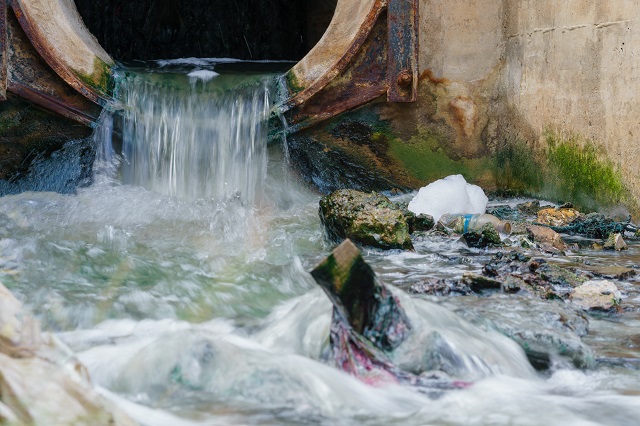
Water treatment is the process of transforming surface water sources into water that is safe to drink. Some surface water sources occur naturally, such as lakes and rivers. Other sources are man-made reservoirs designed to collect drinking water. When water sources are engineered, scientists work to mimic natural processes as much as possible. Water treatment involves the removal of specific physical, biological, and chemical properties to make water safe to consume.
The Water Cycle
The oceans represent the largest areas of water on the Earth. Water also exists in smaller lakes and rivers, underground in hidden reservoirs, at the North and South poles in ice caps, in glaciers on mountains, and in the atmosphere as water vapor. The water cycle involves a specific sequence of steps.
The first step is evaporation of water from the oceans and other bodies of water. The moist air rises and cools, and then water vapor condenses to create clouds. Clouds transport moisture around the Earth, and it falls as precipitation. When precipitation reaches the ground, two things can happen. Some water evaporates back up into the air, and some water penetrates down into the earth, where it becomes ground water. Ground water moves into bodies of water, including oceans, lakes and rivers.
- The Water Cycle
- A Summary of the Hydrologic Cycle
- What Is the Water Cycle?
- Water Cycle Diagram
- Solar Energy and the Water Cycle
- The Water Cycle
- Overview of the Water Cycle
- Summary of the Water Cycle
- The Water Cycle
- Water Cycle (video)
- What Is the Hydrologic Cycle?
- Information About the Water Cycle
History of Water Purification
Water purification originated in Europe during the 18th century. Life-threatening illnesses were rampant in Europe due to sewage-contaminated drinking water, and municipalities began adding chlorine to water to disinfect it to make it safe for drinking. The first regulations regarding drinking water were developed by the United States in 1914.
Eventually, the Environmental Protection Agency took over responsibility for regulating drinking water in 1970, and the Safe Drinking Water Act was passed into law in 1974, with revisions occurring in 1986 and 1996 based on improvements in the analytical methods used to detect contaminants in water. Revisions also addressed issues with the balance of acute and chronic health risks from pathogens in water.
- History of U.S. Water and Wastewater Systems
- Thirst: A Short History of Drinking Water (PDF)
- A Brief History of Drinking Water Regulations (PDF)
- Drinking Water and Health
- A Partial History of Public Water Systems (PDF)
- Water Treatment History
- The History of Water Treatment and How We Came to Have a Good Nose for Clean Water
- History of Clean Drinking Water
The Water Purification Process
Water purification involves three main stages:
- primary treatment,
- secondary treatment, and
- tertiary treatment.
During the primary treatment phase, water is collected and screened before entering initial storage reservoirs. Water may also be preconditioned by adding sodium carbonate to modify hardness levels, and pre-chlorination may also occur to prevent organisms from growing and fouling the water.
Secondary treatment involves the removal of fine solid materials and most contaminants via filters, coagulation, and flocculation. First the pH level is adjusted by adding lime or soda ash, if necessary. Once the right pH balance is found, any remaining particles are removed using coagulation and flocculation. These are purification methods that involve adding chemicals to suspend particles so they can be separated and filtered from the water.
- Coagulation is often done with aluminum sulfate, but some communities also use iron sulfate, iron chloride, or aluminum chloride for coagulation.
- Flocculation involves binding particles to create larger clumps, which are known as floc.
- Floc is then settled then carefully filtered out.
In a water treatment facility, flocculation happens in a large tank, and the mixing process occurs more slowly than coagulation. After the water exits the flocculation basin, it moves to a sedimentation basin for settling and clarification. Filters then separate out the floc from the disinfected water.
Tertiary treatment is the final disinfectant. The water free from small particulates moves into the tertiary treatment process, it is further disinfected to remove any remaining pathogens. This disinfecting process involves adding a form of chlorine, which kills a variety of microorganisms. It’s common to add sodium hypochlorite at the same time as chlorine because this chemical helps reduce dangers associated with chlorine.
- Community Water Treatment
- Water Treatment Process
- Overview of Water Treatment
- Water Purification
- Drinking Water Treatment
- The Water Purification Process
- Overview of the Water Purification Process
- Water Purification
- Water Treatment Process
- Stages in Typical Municipal Water Treatment
 Lead Paint Common Sense
Lead Paint Common Sense  The Reason for Mold Inspection
The Reason for Mold Inspection  Dry Rot: The Invisible Killer
Dry Rot: The Invisible Killer  Enhance Home Design with Decorative Leaded Glass
Enhance Home Design with Decorative Leaded Glass  Condo Renovation Considerations to Save Space
Condo Renovation Considerations to Save Space 

Are You Familiar With This Topic? Share Your Experience.